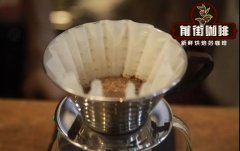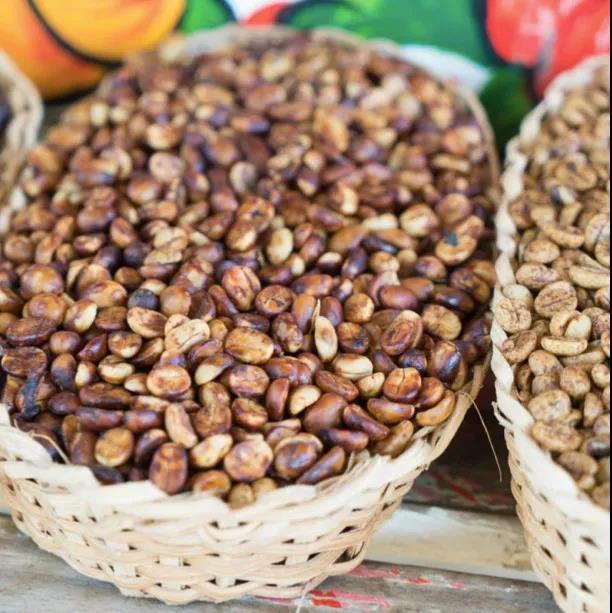Where does the coffee aroma come from? How does coffee taste sweet and sour?

Baking is the most attractive part of the coffee industry. Coffee beans are almost tasteless and taste directly with a rather unpleasant vegetable flavor, but after baking they are transformed into unbelievably aromatic and complex coffee beans. The smell of freshly roasted coffee and ripe beans is refreshing and tastes delicious.
Fast or slow? Shallow or deep?
In short, the roasting of coffee refers to how dark the final color of the coffee beans is (light or deep roasting) and how long it takes (quick or slow). It is not enough to understate that a certain kind of coffee is lightly roasted, because the coffee may be stir-fried quickly or slowly, and different roasting rates can lead to very different flavor performance, although the colors of the beans look very similar.
Coffee undergoes a series of different chemical reactions when it is roasted, many of which reduce its weight and, of course, cause water loss. Slow frying (roasting in 14 minutes and 20 minutes) will have a higher weightlessness ratio (about 16% to 18%), and fast frying can be completed within 90 seconds at most. For a relatively expensive cup of coffee, slow frying will show a better flavor.

During the roasting process, three factors that determine the final flavor of coffee must be properly controlled: sour, sweet and bitter. In general, the longer the overall baking time, the less sour it leaves. On the contrary, the bitterness increases with the increase of baking time, and the deeper the roasted coffee is, the more bitter it will be.
The development of sweetness shows a bell-shaped curve, between the peak of sour taste and bitter taste, and good coffee roasters know how to make coffee beans reach the sweetness peak in each roasting degree. But whether you use a baking method that is both sour and sweet, or a baking method with extremely high sweetness and relatively weak acidity, adjusting the roasting method may not help if the quality of the coffee beans you use is poor.
Sugar in coffee
Many people refer to sweetness when describing the flavor of coffee, and it is important to understand what happens during baking to produce these natural sugars.
Coffee beans contain a certain amount of monosaccharides, although not all sugars are sweet, but these monosaccharides are usually sweet and easily react under the catalysis of coffee roasting temperature. Once most of the water in coffee beans evaporates, sugars begin to react differently with calories, some of which produce caramelization, making some coffee beans caramel-like. In particular, the sweetness of caramelized sugars decreases and eventually becomes one of the sources of bitterness; in addition, some sugars interact with proteins in coffee beans to produce the so-called Maillard reaction (Maillard reactions), which also includes the browning of meat in the oven and the discoloration of cocoa beans when baked.
When the coffee goes through the first explosion stage, the monosaccharides almost do not exist, they may be involved in a variety of different chemical reactions, and eventually transformed into more different types of coffee aromatic compounds.

The acid composition in coffee
Coffee beans have many kinds of sour taste, some taste pleasing, some are not very delicious. For bean bakers, one of the most important acids is chlorogenic acids (CGAs for short). When roasting coffee, a key goal is to completely remove the acid that is not delicious enough, while avoiding creating more negative flavor factors and retaining more pleasing aroma components. In addition, some acids remain stable after baking, such as quinic acid (quinic acid), which adds a pleasing, clean coffee flavor.
Aromatic compounds in coffee
The aroma of most coffee comes from three major reactions during coffee roasting: Maillard reaction, caramelization reaction and Stryker degradation reaction (Strecker degradation, another reaction related to amino acids). These reactions are catalyzed by heat during coffee roasting, resulting in more than 800 different volatile aromatic compounds (aromatic compound), which are the source of coffee flavor.
Although coffee has much more aromatic compounds on record than wine, the same kind of coffee bean has only some aromatic compounds. Many people want to synthesize the aroma of freshly roasted real coffee artificially, but it ends in failure.
Important Notice :
前街咖啡 FrontStreet Coffee has moved to new addredd:
FrontStreet Coffee Address: 315,Donghua East Road,GuangZhou
Tel:020 38364473
- Prev

Will the epidemic affect the price of coffee in 2020? what is the difference in the packaging and transportation of coffee in the new season?
The Covid-19 pandemic has affected the entire coffee supply chain. Coffee shops around the world had to close, bakers began to focus on online sales and subscription programs, and consumers drank more coffee at home than ever before. However, for some people in the coffee industry, the main logistical problem is the transportation of raw coffee. Delays in farms and ports have been
- Next

The difference between the treatment of coffee bean honey and raisin honey by Costa Rican musicians
Professional coffee knowledge exchange more coffee bean information please follow the coffee workshop (Wechat official account cafe_style) the front street coffee and many coffee glutton's evaluation of Costa Rican coffee is that the coffee in this country is quite mild and supple, sour, sweet and chocolate nut bitterness are inclusive, the overall flavor is well balanced. The country's original honey treatment is Costa Rica.
Related
- Beginners will see the "Coffee pull flower" guide!
- What is the difference between ice blog purified milk and ordinary milk coffee?
- Why is the Philippines the largest producer of crops in Liberia?
- For coffee extraction, should the fine powder be retained?
- How does extracted espresso fill pressed powder? How much strength does it take to press the powder?
- How to make jasmine cold extract coffee? Is the jasmine + latte good?
- Will this little toy really make the coffee taste better? How does Lily Drip affect coffee extraction?
- Will the action of slapping the filter cup also affect coffee extraction?
- What's the difference between powder-to-water ratio and powder-to-liquid ratio?
- What is the Ethiopian local species? What does it have to do with Heirloom native species?

